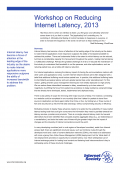Author: Mat Ford
Summary
Internet latency has become a focus of attention at the leading edge of the industry as the desire to make Internet applications more responsive outgrows the ability of increased bandwidth to address this problem. There are fundamental limits to the extent to which latency can be reduced, but there is considerable capacity for improvement throughout the system, making Internet latency a multifaceted challenge. Perhaps the greatest challenge of all is to re-educate the mainstream of the industry to understand that bandwidth is not the panacea, and other optimizations, such as reducing packet loss, are at odds with latency reduction.
For Internet applications, reducing the latency impact of sharing the communications medium with other users and applications is key. Current Internet network devices were often designed with a belief that additional buffering would reduce packet loss. In practice, this additional buffering leads to intermittently excessive latency and even greater packet loss under saturating load. For this reason, getting smarter queue management techniques more widely deployed is a high priority. We can reduce these intermittent increases in delay, sometimes by up to two orders of magnitude, by shifting the focus from packet loss avoidance to delay avoidance using technology that we already have developed, tested, implemented and deployed today.
There is also plenty of scope for removing other major sources of delay. For instance, connecting to a website could be completed in one roundtrip (the time it takes for packets to travel from source to destination and back again) rather than three or four, by folding two or three rounds of flow and security set-up into the first data exchange, without compromising security or efficiency. Motivating industry to deploy these advances needs to be aided by the availability of mass-market latency testing tools that could give consumers the information they need to gravitate towards low latency services, providers and products. There is no single network latency metric but several alternatives have been identified that compactly express aggregate delay (e.g., as relationships or a constellation), and tools that make use of these will give greater insight into the impact of changes and the diversity of Internet connections around the world.
In many developing countries (and in rural regions of developed countries), aside from Internet access itself, there are significant structural issues, such as trombone routes through the developed world and a lack of content distribution networks (CDNs), that need to be addressed with more urgency than Active Queue Management (AQM) deployment, but the ‘blank slate’ of new deployments provides an opportunity to consider latency now. More widespread use of Internet exchange points for hosting local content and fostering local interconnections is key to addressing some of these structural challenges.
The workshop concluded by identifying an action plan to carry the work forward.
